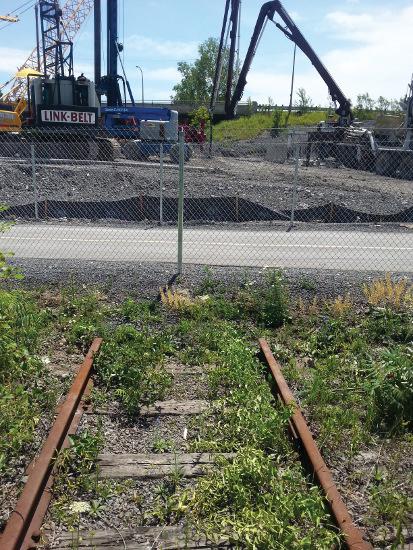
Canada’s Earliest and Most Recent Railway Scandals
By Ann Victoria
Canada’s 150 years are bookended by intriguing railway scandals. The earliest one involved the effort to connect all of our provinces. The latest one, not even a year old, and still awaiting a precedent-setting federal court decision, involves the breaking of an essential railway between Canada’s two founding provinces.
The first scorcher led to the resignation of Sir John A. Macdonald. The second is playing out today.
In the opening years of Confederation, two companies were competing for the federal contract to build a transcontinental railway to British Columbia. The all-Canadian Inter-Oceanic Railway Company led by David Lewis Macpherson was based in Toronto. The Canada Pacific Railway Company of Sir Hugh Allan was based in Montreal, and involved considerable American investment.
 In 1873, Liberal MP Luc Huntington stood up in Parliament to reveal evidence that the Conservative government had given the contract to Canadian Pacific in return for political donations of $360,000 (about $8 million in today’s dollars). In the following days Macdonald protested his innocence, but evidence showed that there was money transferred from Allan to Macdonald, and to his political colleagues. So our first prime minister abruptly resigned in 1873.
In 1873, Liberal MP Luc Huntington stood up in Parliament to reveal evidence that the Conservative government had given the contract to Canadian Pacific in return for political donations of $360,000 (about $8 million in today’s dollars). In the following days Macdonald protested his innocence, but evidence showed that there was money transferred from Allan to Macdonald, and to his political colleagues. So our first prime minister abruptly resigned in 1873.
The so-called ’Pacific Scandal’ was the first major political scandal in Canada after Confederation.
Despite the scandal, Macdonald was re-elected in 1878, and he remained prime minister until his death in 1891.
One of the railway projects that Macdonald’s government oversaw during its second term was construction of the first bridge across the Ottawa River: the one-kilometre-long Prince of Wales Bridge between Ottawa and Hull. This project was protected as being “for the general advantage of Canada” in the Act to Amend The St. Lawrence and Ottawa Railway Act (1872). It was built from 1877-1880 by a wholly-owned company of the Government of Quebec, called the Quebec, Montreal, Ottawa and Occidental (QMO&O) Railway.
That same Prince of Wales Bridge has been in the news in recent months.
In March 2017, Ottawa city council approved a motion instructing Mayor Jim Watson to formalize talks with Gatineau Mayor Maxime Pedneaud-Jobin towards improving their transit connections, in particular across the Prince of Wales bridge.
This inter-provincial rail connection remained intact until just a few months ago. However, in late 2016, the City of Ottawa unceremoniously tore out a quarter-kilometre section of that very track originally installed in 1880, and plunked down the new Bayview Station for the east-west LRT Confederation Line. It was positioned precisely in such a way as to permanently obstruct any future extension of south-north operations by the O-Train to Gatineau.
The placement can’t be accidental.When pressed by the Canadian Transportation Agency, Ottawa quietly admitted in an email to the federal regulator in February 2017, that “the main station building . . . will obstruct the Ottawa River Line.”
The City was responding to a letter from the Agency which communicated the Agency staff’s understanding that: “A portion of the Ottawa River Line . . . that connects the north end of the Ellwood Subdivision with the railway in Gatineau, across the Prince of Wales Bridge, has been removed to construct the new west side entrance to the Bayview Station,” and “the Ottawa River Line will be permanently obstructed in its current alignment.”
Ottawa had to admit to the Agency that “the Ottawa River Line . . . is blocked where it intersects the Bayview Station building.”
The City did offer the comment that – “extension of the O-Train Trillium Line across the Prince of Wales Bridge to Gatineau is part of the ultimate rapid transit network and the 2031 network concept. But the City currently does not have funding available or allocated to build or operate that extension, and so no date has been set for the construction or opening of that service.”
The simple fact is that the City of Ottawa unnecessarily removed and permanently blocked the existing federal track without any federal authorization. And it kindly offers, on behalf of a later city council a decade-and-a-half from now, that it will need to spend tens of millions of dollars to somehow build a bypass track.
The original O-Train plan submitted back in 2000 by the Regional Municipality of Ottawa-Carleton (RMOC) to the Agency, described the O-Train easily continuing on the existing track north past Bayview Station across the Prince of Wales Bridge all the way out to L’Aéroport Exécutif de Gatineau-Ottawa.
Indeed, the written federal certificate of fitness for the O-Train’s operations still says today that the O-Train does run to Quebec!
And the Interprovincial Transit Strategy for Canada’s Capital Region, written by transportation professionals at the NCC, Ottawa and Gatineau listed “O-Train to Gatineau via Prince of Wales Bridge” as one of the priority “Medium Term Actions by 2018.”
Six months ago, it became physically impossible to run that O-Train to Gatineau.
MOOSE Consortium’s director general Joseph Potvin says that city insiders have indicated to MOOSE that there might be a ‘beggar-thy-neighbour’ rationale: to deliberately keep transit in clumsy mode with all areas outside Ottawa’s property tax base.
Could the City of Ottawa’s foreclosing of the No. 1 easy transit option with Gatineau actually be “beggar-thy-neighbour” actions, glossed over with friendly “ever-thy-neighbour” words?
Where indeed are the feds? What’s occurring on their watch runs afoul of the explicit protections for this very section of track passed by the second government of Sir John A. Macdonald, whose legislation quoted Section 92(10)(c) of the Constitution to protect this connecting railway "for the general advantage of Canada.”
The federal regulator has been puttering along for six years with a direct legal challenge by MOOSE Consortium. The company started a legal case in 2011 that informed the Agency about the City’s plans and incremental steps to remove the tracks. Then the company informed the regulator of the violation when a core section of the railway was indeed being dismantled in autumn 2016. And today, some months after the corridor was permanently blockaded, the federal court agency that’s supposed to oversee federal railways has still has not tooted its horn.
This is all happening less than three kilometres from the Agency’s own headquarters, within a clear line of sight from their office windows.
Well, the 150-year history of Canada is riddled with stories of political intrigue involving railways. There’s enough irony in this latest one that you could probably run an imaginary train on it n











